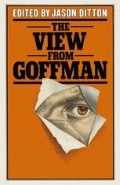Abstract
Built into language, written and spoken, are the means by which we can talk about language, and built into social life are the means by which we define the world, and communicate to others the world we are defining. But the world is actually constituted of multiple worlds with somewhat clear norms within them in which we are erstwhile dwellers. Erving Goffman has published over the course of twenty years or so a series of remarkable volumes on these social worlds and interactions within them. Each focuses and defocuses an aspect of social life. Earlier works investigated performances, their honourings, and the structure in which they were cast; later work, Frame Analysis in particular, concerns the organisation of experience. Frame Analysis draws on earlier work, and could not in fact have been written without the earlier work..In this review of Goffman’s style, I will start ‘backwards’ by considering the issues raised in Frame Analysis, explicating them as matters of style, seeing how much style is structure in most of social interaction, then considering the generic Goffman socio-literary method and procedure, and return to Frame Analysis, its strengths and limits as a form of structuralism.
Access this chapter
Tax calculation will be finalised at checkout
Purchases are for personal use only
Preview
Unable to display preview. Download preview PDF.
Chapter Endnotes
A. R. Radcliffe-Brown, A.Natural Science of Society, ( Glencoe, Illinois; Falcon’s Wing Press, 1957 )
see the comment by Edmund Leach, ‘Social Anthropology: A Natural Science of Society’, Proceedings Of the British Academy, Volume LXIV, (Oxford; Oxford University Press, 1976 ).
Peter Berger and Thomas Luckmann, The Social Construction of Reality, ( New York; Doubleday Anchor, 1966 ).
Harold Garfinkel, ‘Common-Sense Knowledge of Social Structures: A Documentary Method of Interpretation’, pp. 689–712, in J. Scher (ed) Theories of the Mind, ( New York; Free Press, 1962 ).
See, Peter K. Manning, ‘Police Lying’, Urban Life and Culture, Volume 3, (1974) PP. 283–306.
See, Everett C. Hughes, Men and Their Work, (New York; The Free Press of Glencoe, 1958 ).
See, Manning, 1976, op. cit., p. 18. Unlike the gamelike encounter-oriented sociology Goffman fostered and popularised in a dramatically rendered series of volumes published in the sixties, Relations in Public contains a deeply disturbing picture of everyday life. [However, note the forboding remarks in Goffman, (1967) pp. 147–8]. This shift is also discussed by Berman (1971, R2) op. cit., and by Alan Dawe, ‘The Underworld View of Erving Goffman’, British Journal of Sociology, volume 24, (1973), PP. 246–53.
Kenneth L. Burke, Permanence and Change, 2nd. and rev. ed., (Indianapolis; Bobbs-Merrill, 1965 ) p. 65.
See, Peter K. Manning and M. Zucker, The Sociology of Mental Health and Illness, ( Indianapolis; Bobbs-Merrill, 1976 ).
And here see: Manning and Zucker, ibid.; H. Fabrega Jnr., Disease and Social Behaviour, (Cambridge; M.I.T. Press, 1974 )
H. Fabrega Jnr., and Peter K. Manning, ‘Disease, Illness and Deviant Careers’, in R. A. Scott and J. D. Douglas (eds) Theoretical Perspectives on Deviance, ( New York; Basic Books, 1972 )
Peter, K. Manning and H. Fabrega Jnr., ‘The Experience of Self and Body: Health and Illness in the Chiapas Highlands’, in G. Psathas (ed) Phenomenological Sociology, ( New York; J. Wiley and Sons, 1973 ).
This technique can result in misreading Goffman’s aim, as S. Messinger, R. Sampson and R. Towne point out in their article, ‘Life as Theatre: Some Notes on the Dramaturgic Approach to Social Reality’, Sociometry, volume 25, (September, 1962 ) pp. 98–110.
Paul Rock, ‘Symbolic Interactionism’, in R. B. Smith and Peter Manning (eds) Social Science Methods Volume I: Qualitative Methods, (New York; Irvington Press, Forthcoming).
See, Peter Manning, ‘Existential Sociology’, Sociological Quarterly, volume 14, (1973) pp. 283–306; and Tiryakian (1967, R3) [See: Editor’s Introduction for a full reference to this, together with a list of other reviews in the section, A Sampler of Reviews].
Gregory Bateson, Naven, (Stanford; Stanford University Press, originally published, 1936); 2nd ed., (1958)
Gregory Bateson, Steps to an Ecology of Mind, (San Francisco; Chandler, 1972). The term frame, and analogous concepts with the same salutory ambiguity are found in several other works, but none has developed the idea as fully as has Goffman in Frame Analysis. Among the more important writers using and developing the term are, Mary Douglas, Basil Bernstein, Pierre Bourdieu, Clifford Geertz and Victor Turner. The idea is used in sociolinguistics (sometimes as ‘context’)
some clues to the tradition are found in B. N. Colby et al., ‘Ethnographic Semantics: A Preliminary Survey’, Anthropology, volume 7, (February, 1966) pp. 3–32. These writers all seek to refine a concept which simultaneously captures the literal and metaphoric aspects of social life, and their works vacillate in emphases between these two. Unfortunately, a critical review of the use of the concept and its refinement by Goffman is beyond the scope of this chapter.
Cf. G. A. Miller, ‘The Magical Number Seven, Plus or Minus Two: Some Limits on our Capacity for Processing Information’, Psychological Review, volume 63, (1956) pp 81–97
Peter McHugh, Defining the Situation, ( Indianapolis; BobbsMerrill, 1968 )
A. F. C. Wallace, ‘One Just Being Complicated Enough’, Proceedings of the National Academy of Science, volume 47, (1961) pp. 458–64.
Editor information
Copyright information
© 1980 Peter K. Manning
About this chapter
Cite this chapter
Manning, P.K. (1980). Goffman’s Framing Order: Style as Structure. In: Ditton, J. (eds) The View from Goffman. Palgrave Macmillan, London. https://doi.org/10.1007/978-1-349-16268-0_10
Download citation
DOI: https://doi.org/10.1007/978-1-349-16268-0_10
Publisher Name: Palgrave Macmillan, London
Print ISBN: 978-1-349-16270-3
Online ISBN: 978-1-349-16268-0
eBook Packages: Palgrave Social & Cultural Studies CollectionSocial Sciences (R0)

